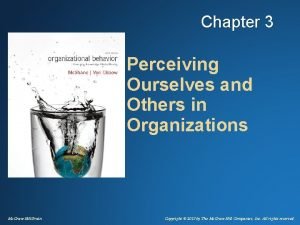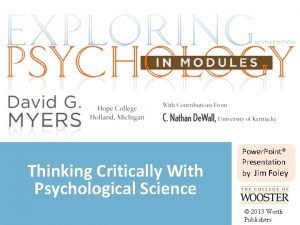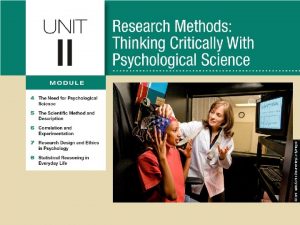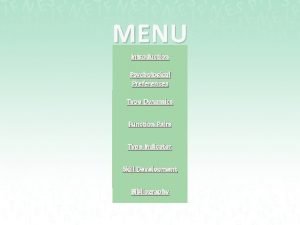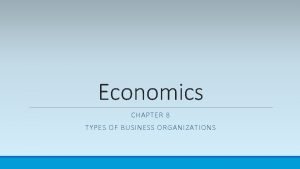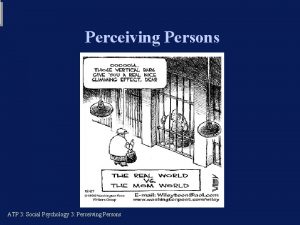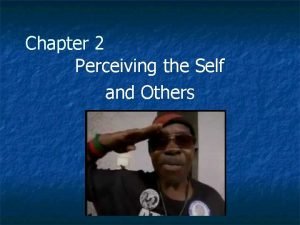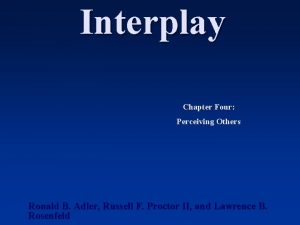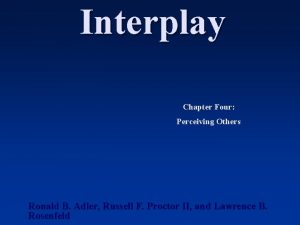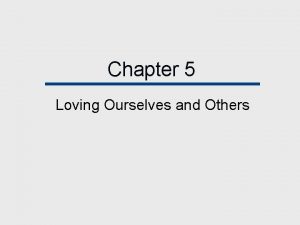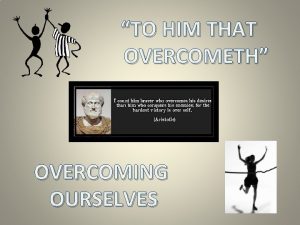Chapter 3 Perceiving Ourselves and Others in Organizations














- Slides: 14

Chapter 3 Perceiving Ourselves and Others in Organizations Mc. Graw-Hill/Irwin Copyright © 2013 by The Mc. Graw-Hill Companies, Inc. All rights reserved.

Self-Concept Dimensions (3 C’s) § Complexity • People have multiple self-views § Consistency • Similar personality and values across multiple selves § Clarity • Clearly and confidently described, internally consistent, and stable across time. § People have better well-being with: • multiple selves (complexity) • well established selves (clarity) • selves are similar and compatible with traits (consistency) 3 -2

Self-Enhancement and Self. Verification § Self-enhancement • Drive to promote/protect a positive self-view - competent, attractive, lucky, ethical, valued • Positive self-concept outcomes: - better personal adjustment and mental/physical health - inflates personal causation and probability of success § Self-verification • • Motivation to verify/maintain our self-concept Stabilizes our self-concept People prefer feedback consistent with their self-concept Self-verification outcomes: - Tend to perceive information consistent with our self-concept - We interact more with those who affirm our self-concept 3 -3

Self-Evaluation and Social Self § Self-evaluation • Self-esteem – extent that we like and respect ourselves • Self-efficacy -- belief in one’s ability, motivation, role perceptions, and situation to complete a task • Locus of control -- general belief about personal control over life events § Social Self • Social identity -- defining ourselves in terms of groups to which we belong or have an emotional attachment • We identify with groups that support self-enhancement 3 -4

Perception Defined § The process of receiving information about and making sense of the world around us • Determining which information gets noticed • how to categorize this information • how to interpret information within our existing knowledge framework 3 -5

Selective Attention Selecting vs ignoring sensory information § Affected by object and perceiver characteristics § Emotional markers attached to selected information § Confirmation bias § • Information contrary to our beliefs/values is screened out 3 -6

Perceptual Organization/Interpretation § Categorical thinking • Mostly nonconscious process of organizing people/things § Perceptual grouping principles • Similarity or proximity • Closure -- filling in missing pieces • Perceiving trends § Interpreting incoming information • Emotional markers automatically evaluate information 3 -7

Stereotyping Through Categorization, Homogenization, Differentiation Social identity and self-enhancement reinforce stereotyping through: § Categorization -- Categorize people into groups § Homogenization -- Assign similar traits within a group; different traits to other groups § Differentiation -- Assign less favourable attributes to other groups 3 -8

Attribution Rules Internal Attribution Frequently Seldom Consistency Distinctiveness Consensus Seldom Frequently External Attribution 3 -9

Self-Fulfilling Prophecy Cycle Supervisor forms expectations Employee’s behavior matches expectations Expectations affect supervisor’s behavior Supervisor’s behavior affects employee 3 -10

Self-Fulfilling Prophecy Effect is Strongest. . . § . . . at the beginning of the relationship (e. g. employee joins the team) § . . . when several people have similar expectations about the person § . . . when the employee has low rather than high past achievement 3 -11

Other Perceptual Effects § Halo effect • One trait affects perception of person’s other traits § False-consensus effect • overestimate how many others have similar beliefs or traits like ours § Primacy effect • First impressions § Recency effect • Most recent information dominates perceptions 3 -12

Strategies to Improve Perceptions 1. Awareness of perceptual biases 2. Improving self-awareness • Applying Johari Window 3. Meaningful interaction • Close, frequent interaction toward a shared goal • Equal status • Engaged in a meaningful task 3 -13

Global Mindset § An individual’s ability to perceive, appreciate, and empathize with people from other cultures, and to process complex cross-cultural information. • awareness of, openness to, and respect for other views and practices in the world • capacity to empathize and act effectively across cultures • ability to process complex information about novel environments • ability to comprehend and reconcile intercultural matters with multiple levels of thinking 3 -14
 Perceiving ourselves and others in organizations
Perceiving ourselves and others in organizations The process of seeing ourselves through the eyes of others
The process of seeing ourselves through the eyes of others Perceiving order in random events example
Perceiving order in random events example Closure-oriented/judging vs. open/perceiving
Closure-oriented/judging vs. open/perceiving Perceiving order in random events psychology examples
Perceiving order in random events psychology examples Judging vs perceiving
Judging vs perceiving N vs s mbti
N vs s mbti Perceiving vs judging
Perceiving vs judging Introduction to management and organization
Introduction to management and organization Chapter 3 information systems organizations and strategy
Chapter 3 information systems organizations and strategy Our awareness of ourselves and our environment.
Our awareness of ourselves and our environment. Our awareness of ourselves and our environment.
Our awareness of ourselves and our environment. Awareness of ourselves and our environment is
Awareness of ourselves and our environment is Our awareness of ourselves and our environment
Our awareness of ourselves and our environment Chapter 8 types of business organizations
Chapter 8 types of business organizations
